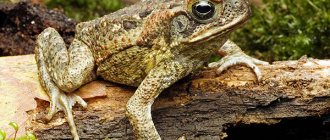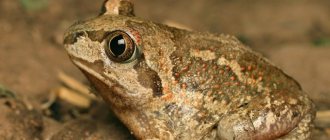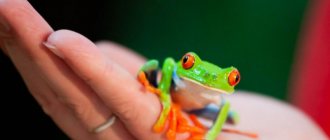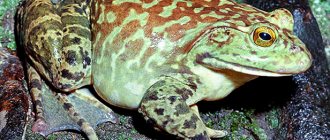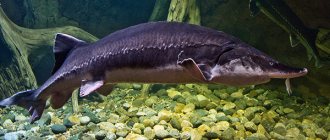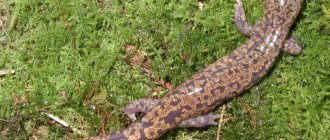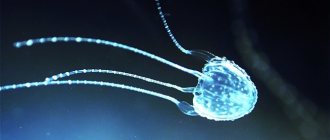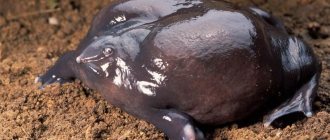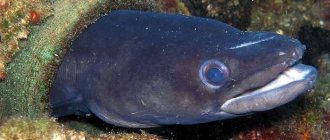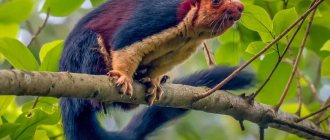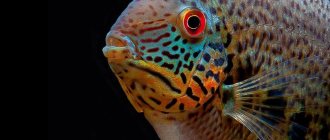The ancient ancestors of frogs appeared on Earth approximately 290 million years ago, and nature decreed that the most beautiful representatives of tailless amphibians are also the most dangerous. Tree frogs, frogs and toads mostly use toxic poisons for defense, and rarely attack first. Our short review presents the most poisonous frogs that have chosen the tropical forests, swamps and reservoirs of our amazing planet. And you can see the most poisonous insects in the article on our website TopCafe.su.
Here are the most poisonous frogs in the world:
13
Phyllomedusa bicolor
Among the tropical forests located in the Amazon basin, there lives such a beautiful, but rather dangerous phyllomedusa from the tree frog family.
The poison is not very toxic, but can cause gastrointestinal upset, hallucinations, and severe allergies. Local Indians use its poison to treat all kinds of diseases and in initiation rites to enter a trance.
It is often called the monkey frog, and its habits make it a very curious amphibian. The species is listed as endangered and is therefore protected.
12
Striped leaf climber / Phyllobates vittatus
These colored frogs, living in the southwest of Costa Rica, with their striking appearance warn that they are dangerous and it is better to avoid these wonderful creatures.
Easily identified by the characteristic yellow stripe running down the back. The stripes run along the head and along the sides of the abdomen, which is why the frog received its specific name.
It is not possible to notice it right away, since it prefers to hide in crevices and between stones. The poison, when it gets on human skin, causes severe pain and can even lead to paralysis.
11
Peeps
The Surinamese pipa has an equally interesting way of caring for its offspring. Here the mother becomes the main one. After the male fertilizes the eggs in the water, she dives under them and catches them on her back. The father actively helps, pressing them on the mother's back with his paws. After this, the female grows a special skin film that covers the incubator. Once the baby frogs are fully formed, they break through the skin and climb out. After this, the mother’s back resembles... an empty egg cage, covered in cells.
Blue Darter / Dendrobates azureus
The cute creature, as seen in the photo, with a characteristic blue coloration, prefers savannas and tropical rainforests, and feeds mainly on small insects.
Even a small concentration of poison is enough to kill large natural enemies, and deaths among humans have also been recorded in history. They grow up to 5 cm in length, and live among the foliage, gathering in groups of up to 50 individuals.
Despite the mortal danger, wildlife lovers keep the American inhabitant as a pet.
10
Goliath frog
Frogs with a beautiful name can only be found in Equatorial Guinea and southwestern Cameroon. Length – up to 32 cm, weight – up to 3250 g. The back is greenish-brown, and the belly is bright yellow.
Goliath frogs are picky and will not live in swamps. Their habitat is waterfalls of tropical rivers. They love to sit on rock ledges. Despite their impressive size, frogs feed on insects and spiders, worms, and other amphibians.
Goliath is in danger of destruction. Living conditions are changing, and amphibians are dying out. Not without human influence, people exterminate frogs for further consumption or export abroad.
Charming leaf climber / Phyllobates lugubris
The species name of the inhabitant of the Atlantic coast of Central America fully corresponds to the appearance of the frog. Multi-colored stripes run along the black body, from yellow to bright golden.
Not as poisonous as other representatives of the leaf climber genus, but able to defend itself from natural enemies. Possessing poison, it does not hide much, so it can easily be found on forest paths and the banks of rivers and reservoirs.
They are distinguished by leaf climbers and huge bulging eyes on a relatively small head.
9
Shieldbacks
The evil shieldback is an active predator that is not averse to “inviting” its relative to dinner. And then eat it, cannibalism is common in this species.
The cocoon scutum is not afraid of drought; it simply remains in a dry body of water. Every day she sheds, but does not shed her skin, as a result a protective cocoon is formed.
Red-backed poison frog / Ranitomeya reticulatus
This beauty, with a medium-strength venom, lives among the natural beauties of Peru. It got its name from the characteristic red color of its back, while the rest of the body is spotted.
Despite the not very toxic poison produced by the glands of the frog, it is enough to cause health problems in humans, as well as kill the animal.
The frog receives poison by eating poisonous ants, and uses it in moments of danger. At other times, it is stored in glands on the frog's body.
8
Amphibian breathing
Amphibians breathe through their lungs and skin. The grass frog receives 33% of oxygen through its skin. The exchange of gases through the skin with the environment in amphibians occurs only through the water film, so the skin is constantly moistened with mucus produced by numerous glands. In the sun, the film on the skin dries out and prevents moisture loss.
For protection, toads have poisonous glands that secrete substances with a pungent odor, a very bitter taste, a burning and emetic effect. After all, they cannot move quickly and escape from the hunter. The venom of gray and green toads is not dangerous to humans, especially since it is released only under mechanical pressure.
Spadefoot, accidentally dug out of the ground
Chiriquita toad
In Panama and Costa Rica you can find one of the most poisonous toads, which has a bright color and does not grow more than 5 cm. Note that males are usually smaller and reach a length of only 3 cm.
When poison gets on the skin, the channels of nerve endings are blocked, and the person experiences a loss of coordination of movement, the person begins to have convulsions, and the sad result of all this can be complete paralysis.
Unfortunately, an antidote has not yet been invented, but it is necessary to carry out general detoxification in time, and then irreparable consequences for the health of the human body can be avoided.
7
Slingshot changeable
It is also called the Brazilian slingshot . These frogs live exclusively in South America. They reach a length of 20 cm. They have a rather terrifying appearance, with horns and a crest growing on their heads. The color resembles camouflage: green, brown with dark spots, blurred contours.
Variable slingshots have an aggressive character. Known for their excellent appetite. Birds, rats and even... relatives are used. Frogs are not embarrassed even by the fact that the prey is larger than them. There are frequent cases of death from suffocation, the slingshot can neither swallow nor spit out its lunch.
Poison tree frog / Trachycephalus venulosus
A rather large frog, growing up to 9 cm in length, comes from Brazil, which is why it is also called the Brazilian tree frog.
It has an unusual coloration, consisting of spots of various sizes, forming a concentric pattern throughout the body. A distinctive feature is also the small red spots on the back and neck of the amphibian.
They prefer to live most of their lives in trees, and during breeding periods they move closer to bodies of water. Females lay eggs in ponds and lakes, which can dry out, but the offspring still survive early.
By the way, if you haven’t looked at our article about the most unusual species of frogs, be sure to do so!
6
Long-legged litoria
Perhaps this beauty will be able to compete even with the frog princess. Unfortunately, it can only be found in New Guinea and Australia. It has quite impressive dimensions: maximum length is 14 cm.
Females are often larger than males. They have a bright green color. They live mainly in the forest in trees; the long-legged litoria , although sometimes they descend to the ground for prey. They are active at night.
Little poison dart frog / Oophaga pumilio
A very tiny, red tropical frog lives high in the mountains among the ancient trees of the tropical forests of Central and South America.
Bright, literally flashy coloring is a warning signal. It is better to avoid it so as not to get severe burns and health problems.
The poison is concentrated in the glands, and they get it by eating poisonous ants. It is noteworthy that it has one natural enemy - the common tree frog, which is not affected by poison dart frog.
5
Whistling
Representatives of this family are united by the ability to make whistling sounds when moving. The ocellated whistler has spots with a border on its skin, very similar to eyes. And the five-fingered one is famous for the fact that it calmly eats its deadly relatives - poison dart frogs. And he himself is quite poisonous, sometimes just standing next to him is enough to start sneezing.
Bernhard's Mantella / Mantella bernhardi
A resident of the island of Madagascar hides among fallen leaves, hunting for flies and other insects.
It has a characteristic black color, and males also have a horseshoe-shaped spot on their neck. Females do not have such a pattern, but they are larger in size than males.
A frog is not born poisonous, but over time the skin produces toxic poison, which leads to burns and allergies. This species of mantella leads the most active lifestyle among other African species.
4
Garlic
This frog may not make much of an impression on you. The average body length is 8 centimeters, and the maximum weight is 20 grams, but compared to some other species of amphibians, it is large in size.
Appearance is unremarkable: the body is wide and short, the color is dull, usually gray shades with brown or black spots.
Spadefoots belong to the terrestrial species. They are nocturnal and settle in floodplains of rivers and lakes. Frogs choose places transformed by humans; they are attracted to loose soil. At night they completely bury themselves in it.
There is an opinion that people who have spadefoots living in their garden plots or vegetable gardens are very lucky. They not only destroy pests, but also loosen the soil. Garlic mushrooms are absolutely safe for humans.
Common Toad / Bufo bufo
The distribution area of the gray toad is quite extensive, from the Siberian expanses of Russia to the western tip of Europe and North Africa.
The largest toad living in Europe is also poisonous. The poisonous toad is especially dangerous to livestock, as well as to humans. It is extremely undesirable for the venom of this amphibian to get into the eyes or onto the oral mucosa.
Another interesting point: in times of danger, the toad takes a threatening pose, rising high on its paws.
3
grass frog
The most common species in Europe, their range is from the British Isles to Western Siberia. These frogs prefer forests or forest-steppe zones.
Grass frogs are quite cute and have a non-repulsive appearance. Body length is up to 10 cm, weight up to 23 g, but there are exceptions to the rules - larger specimens.
The color depends on the habitat, usually it is gray, brown, dark green, occasionally red or black individuals are found. By the way, frogs of this species do not croak; they make sounds similar to the purring of a cat.
Spotted poison frog / Ranitomeya variabilis
You can meet this forest beauty, whose body is painted with spots of different colors and sizes, only in the vastness of Peru, and also in Ecuador.
But this beauty is deceptive, as the frog is one of the most poisonous creatures in Latin America. Even a small amount of poison is enough to kill 5 people.
The venom is so toxic that light touching an amphibian can cause great harm to health. One consolation is that the frog is very calm and will never attack first.
2
World rankings
Frogs and their varieties live not only in North and South America. They are distributed all over the world. The diversity of these amphibians makes it possible to organize real competitions in different categories. Let's find out who is the best among them.
Attractive and deadly
This category presents those beauties whose poison can lead to instant or long and painful death. By the way, in some cases there is simply no antidote. So, who should not be touched, but can only be admired:
- bicolor phyllomedusa with venom that has a hallucinogenic “effect”;
- a spotted poison dart frog with a poisonous skin, by the way, local residents use the secreted secretion to... breed new breeds of parrots, it has a strange effect on their plumage - it changes their color;
- the redback, which lives by the “don’t touch” principle, releases poison only when there is danger;
- the little poison dart frog is colored according to its ability: it is red and stings, the burns can be quite deep;
- spotted poisonous one portion of secretion can kill 5 people;
- leaf climbers: striped with nerve paralytic and three-banded with analgesic poisons (the latter species is capable of producing an “analog” of morphine).
These frog leaders are so formidable.
Rare species
Unfortunately, man, through his activities and activity in the development of wild nature, has caused a lot of harm. Some amphibians are almost never seen. The rarest are:
- golden toad;
- frogs: grass, horned, slippery tree frogs;
- no less rare are frog ones with unusual names: “hourglass”, “mesh glass”, “eyelashes”.
Unusual
In each family you can find its own unique one. The “unusual” category includes frogs:
- hairy: not only do the patches of skin on males resemble hair during mating, but she can also break through the skin with her knuckles, turning her paw into a formidable weapon with sharp claws;
- When in danger, the badjeta is inflated into a perfectly round ball;
- Panamanians communicate with each other not only by whistling, but also by “gestures”;
- and the sharp-faced swamp completely changes color during the mating season, simply turning blue in anticipation of a pleasant meeting;
- the Indian rainbow is capable of changing color, which it does constantly, and not completely, but “in parts”;
- glass or transparent - no comments, just a jumping “anatomical manual”;
- When you see a moss tree (lives in China), you won’t immediately understand whether it’s a living creature or a piece of moss on a rock;
- and the luminous night one, on the contrary, is clearly visible, especially in the dark;
- the flying one uses its membranes to jump long distances, well, like a flying squirrel;
- The lemur phyllomedusa with its eyes is very reminiscent of... a lemur.
Here they are, amazing and unusual representatives of amphibians, living in different parts of the world. Charming, aren't they?
Yeah / Rhinella marina
The poisonous tropical toad takes an honorable second place among all toads, but its toxicity makes it a leader among poisonous amphibians.
The largest specimen reached a size of 24 cm, although on average the toad grows from 15 to 17 cm. It comes from Central America, but to fight insects they were brought to Australia, from where Aga settled on the islands of Oceania.
The strongest poison affects the heart and affects the nervous system. The most dangerous thing is that the green toad can shoot poison over a distance.
1
Tiger frog
Tiger frogs are distributed from India to Pakistan. They love humidity, their element is ponds and lakes. The length of representatives of this species reaches 17 cm.
The color can be olive, dark green, gray. During the mating season, the appearance of males changes dramatically. They turn bright yellow and the throat sacs change color to bright blue. Real handsome men, females will not be able to refuse them.
Tiger frogs are nocturnal. They are very voracious, eating insects, snakes and even small rodents and birds. If the prey is too large, the frogs push it into their mouths using their paws.
For reference: these amphibians are very popular in their homeland and are eaten there. There are even farms for breeding them.
Terrible leaf climber / Phyllobates terribilis
A small inhabitant of the rainforests on the southwestern tip of Colombia, the most poisonous frog in the world.
Adults grow no more than 2–4 cm, and the color is contrasting and quite bright. Yellow frogs are so poisonous that even a slight touch to it is enough to cause death. Phyllobates terribilis is born non-poisonous, and then, by consuming insects, it produces poison.
The most interesting thing is that in captivity, the Colombian poison frog gradually loses its poisonousness, since the diet does not contain insects, which contribute to the production of the deadly poison.
?
Beelzebub the Frog
Leader among large frogs. Length – 40 cm, weight – 4500g. There is only one caveat: the frog is a fossil. At the moment it can only be seen in museums. The Aral Sea habitat is Madagascar, it was in this area that fragments of skeletons were found.
Beelzebub frogs are believed to be relatives of the slingshot variable. There are some similarities in appearance and behavior. Perhaps they had the same aggressive character, attacking prey from ambush. Scientists believe that Beelzebub's frogs' diet included newborn dinosaurs.
5 0
Summarize
So we met some beautiful, but very dangerous frogs. Unfortunately, reports about people being poisoned by frogs quite often appear on news feeds. In nature, everything is thought out to the smallest detail, and the unusual color and appearance of amphibians acts as a kind of warning that this is a dangerous and poisonous creature.
The editors of TopCafe wish you to meet these amazing animals only on the screen or in a terrarium. We look forward to your comments about the most poisonous frogs on the planet.
Editor's note: This article has been updated since its original publication in November 2022.
Breeding at home
No matter how strange it may sound, modern exotic lovers are increasingly choosing poisonous amphibians as pets. Which is not at all surprising, because huge terrariums with colorful frogs sitting among lush vegetation are not only pleasing to the eye, but also resemble a piece of the jungle.
Modern exotic lovers are increasingly choosing poisonous amphibians as pets.
And, most importantly, keeping such an amphibian at home is absolutely safe, since in an artificial environment it completely loses its poisonous qualities. This is primarily affected by changes in the diet and living conditions of the amphibian.
The most popular terrarium frogs today are dart frogs. The main advantages of these amphibians:
- easy care;
- the diversity and beauty of the frog;
- small sizes;
- Dart frogs are completely comfortable at room temperature;
- even same-sex individuals get along well in the same terrarium;
- have interesting behavior.
Terrarium for an amphibian
Dart frogs are kept in horizontal terrariums with moderate humidity and good ventilation. The dimensions of such a “house” must first of all be selected based on the size of the terrarium vegetation, which these frogs absolutely need. For example, 2-3 pairs of individuals will feel great on an area measuring 60 by 60 cm with a wall height of about 50-70 cm.
Medium or coarse gravel can be used as soil. It is very important that the stones are constantly slightly moistened, so they must be sprayed with settled water once a day.
Medium or coarse gravel can be used as soil for frogs.
Room temperature from + 22 to + 27 °C is perfect for dart frogs, but at night it can be lowered to +18 °C. Such conditions are quite sufficient for the normal life of both amphibians and terrarium plants. Since poison dart frogs are diurnal amphibians, special attention should be paid to lighting: frogs should be provided with good light for 12 hours.
In addition, amphibians vitally need ultraviolet light, so it is very important that the terrarium is equipped with such a device. In no case should you use special heating lamps designed for reptiles (especially desert lizards and turtles), since in strong light the delicate skin of amphibians simply burns.
Amphibians vitally need ultraviolet light, so it is very important that the terrarium is equipped
Low varieties with large leaves, such as tradescantia and various representatives of bromeliads, are well suited for vegetation. A thick piece of driftwood or a small part of a tree trunk is also required. A constant supply of fresh water is extremely important, which is recommended to be kept in a coconut shell.
Nutrition and reproduction
Experienced breeders traditionally feed poison dart frogs with fruit flies, the favorite delicacy of these frogs. However, a novice owner of amphibians may have some difficulties with such “food” (flies have the not very pleasant feature of scattering throughout the apartment), so at the initial stage the frogs can be fed with caterpillar larvae or springtails.
The transformation of a tadpole into a frog is a long process that will take 2-3 months.
Dart frogs reach sexual maturity at about one year of age. After fertilization, females lay a very small number of eggs (only 3-5 pieces) in various shelters. After approximately 20-25 days, small tadpoles appear and are immediately transferred to a small plastic container with clean water. The young are fed with the usual mixture for fry of aquarium fish. The transformation of a tadpole into a frog is a rather long process, which will take 2-3 months.
Thus, even very dangerous and deadly frogs can turn into cute apartment pets, delighting their owner every day with their funny behavior and beauty.
https://youtube.com/watch?v=wpWei7ryjAQ
